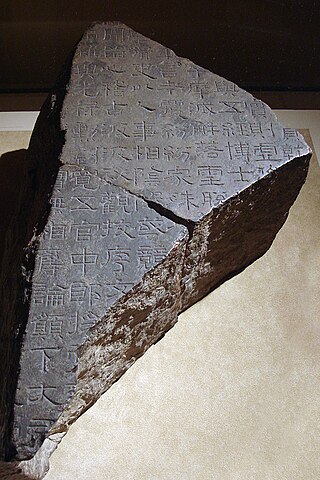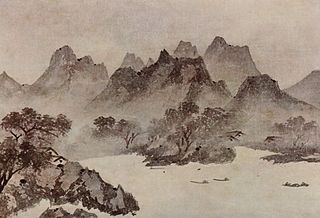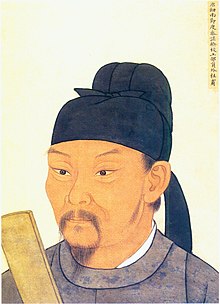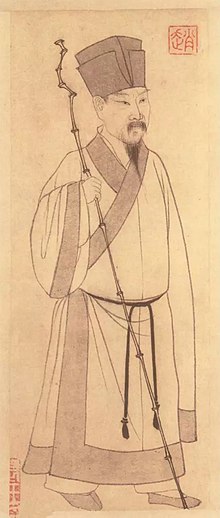
Chinese poetry is poetry written, spoken, or chanted in the Chinese language, and a part of the Chinese literature. While this last term comprises Classical Chinese, Standard Chinese, Mandarin Chinese, Yue Chinese, and other historical and vernacular forms of the language, its poetry generally falls into one of two primary types, Classical Chinese poetry and Modern Chinese poetry.

Classical Chinese poetry is traditional Chinese poetry written in Classical Chinese and typified by certain traditional forms, or modes; traditional genres; and connections with particular historical periods, such as the poetry of the Tang dynasty. The existence of classical Chinese poetry is documented at least as early as the publication of the Classic of Poetry (Shijing). Various combinations of forms and genres have developed over the ages. Many or most of these poetic forms were developed by the end of the Tang dynasty, in 907 CE.

The Chu Ci, variously translated as Verses of Chu, Songs of Chu, or Elegies of Chu, is an ancient anthology of Chinese poetry including works traditionally attributed mainly to Qu Yuan and Song Yu from the Warring States period, as well as a large number of works composed during the Han dynasty several centuries later. The traditional version of the Chu Ci contains 17 major sections, anthologized with its current contents by Wang Yi, a 2nd-century AD librarian who served under Emperor Shun of Han. Classical Chinese poetry prior to the Qin dynasty is largely known through the Chu Ci and the Classic of Poetry.

Yu Xin (513-581) was a Chinese poet, politician, and writer of the Liang and Northern Zhou dynasties of medieval China. Yu Xin was one of the founders of the Xu-Yu literary style together with Xu Ling, and the author of a famous fu. His courtesy name was Zǐshān (子山), and he was known as Yu Shin in Japan.
Shen Quanqi, also known as Yunqing, was a Chinese poet and government official active during the Tang dynasty, and the interluding "restored Zhou dynasty" of Wu Zetian. Shen Quanqi is especially known for his work in developing and perfecting the regulated verse form of Classical Chinese poetry. Shen's poetry ranges from the elegant court style of the poetry which he wrote while at court and the intensely anguished poems which he wrote during his years of exile, in the extreme south of the empire.

Tang poetry refers to poetry written in or around the time of or in the characteristic style of China's Tang dynasty, and/or follows a certain style, often considered as the Golden Age of Chinese poetry. The Complete Tang Poems includes over 48,900 poems written by over 2,200 authors. During the Tang dynasty, poetry continued to be an important part of social life at all levels of society. Scholars were required to master poetry for the civil service exams, but the art was theoretically available to everyone. This led to a large record of poetry and poets, a partial record of which survives today. The two most famous poets of the period were Li Bai and Du Fu. The Qing dynasty selection, Three Hundred Tang Poems, has made Tang poetry familiar to educated Chinese in modern times.

The Eight Views of Xiaoxiang are scenes of the Xiaoxiang region, in what is now modern Hunan Province, China, that were the subject of the poems and depicted in well-known drawings and paintings from the time of the Song Dynasty. The Eight Views of Xiaoxiang can refer either to various sets of paintings which have been done on this theme, the various verse series on the same theme, or to combinations of both. The Xiaoxiang theme is part of a long poetic and artistic legacy.
Song poetry refers to Classical Chinese poetry of or typical of the Song dynasty of China, established by the Zhao family in China in 960 and lasted until 1279.

Classical Chinese poetry genres are those genres which typify the traditional Chinese poems written in Classical Chinese. Some of these genres are attested to as early as the publication of the Classic of Poetry, dating from a traditionally, and roughly, estimated time of around 10th–7th century BCE, in what is now China, but at that time was composed of various independent states. The term "genres" refers to various aspects, such as to topic, theme, and subject matter, what similes or metaphors were considered appropriate or how they would be interpreted, and other considerations such as vocabulary and style. These genres were generally, but not always independent of the Classical Chinese poetry forms. Many or most of these forms and genres were developed by the Tang dynasty, and the use and development of Classical Chinese poetry genres actively continued up until the May Fourth Movement, in 1919, and still continues even today in the 21st century.

Xiaoxiang, also transliterated XiaoXiang, Hsiao Hsiang, and Chiu Chiang, in some older sources, refers to the "lakes and rivers" region in south-central China south of the middle-reaches of the Yangtze River and corresponding, more or less, with Hunan province. Xiaoxiang is less a precise geographic entity than a concept. Xiaoxiang is used in the genre of Xiaoxiang poetry of Classical Chinese poetry and in literature for symbolic purposes, in part because this was a significant area, which at least through the Song dynastic era China was still considered a wild place full of malaria, barbarians, and wild beasts. Indeed, for much of early Chinese history, this area belonged not to China, but to the independent state of Chu. Beginning at least with Qu Yuan, in the third century BCE, this region came to symbolically represent the unjust exile of a talented minister or government official by an unappreciative king or emperor.

Han poetry as a style of poetry resulted in significant poems which are still preserved today, and whose origins are associated with the Han dynasty era of China, 206 BC – 220 AD, including the Wang Mang interregnum. The final years at the end of the Han era often receive special handling for purposes of literary analysis because, among other things, the poetry and culture of this period is less than typical of the Han period, and has important characteristics of its own, or it shares literary aspects with the subsequent Three Kingdoms period. This poetry reflects one of the poetry world's more important flowerings, as well as being a special period in Classical Chinese poetry, particularly in regard to the development of the quasipoetic fu; the activities of the Music Bureau in connection with the collection of popular ballads and the resultant development of what would eventually become known as the yuefu, or as the rhapsodic formal style; and, finally, towards the end of the Han dynasty, the development of a new style of shi poetry, as the later development of the yuehfu into regular, fixed-line length forms makes it difficult to distinguish in form from the shi form of poetic verse, and at what point specific poems are classified as one or the other is somewhat arbitrary. Another important poetic contribution from the Han era is the compilation of the Chuci anthology, which contains some of the oldest and most important poetic verses to be preserved from ancient China, as well as the transmission of the Shijing anthology.

The History of fu poetry covers the beginnings of the Chinese literary genre of fu. The term fu describes literary works that have certain characteristics. English lacks an equivalent term. Sometimes called "rhapsodies", sometimes "rhyme-prose", fu have qualities of both poetry and prose: both are obligatory. The fu form is a poeric treatment, wherein a topic of interest, such as an exotic object, a profound feeling, or an encyclopedic subject, is described and rhapsodized upon, in exhaustive detail and from various angles. For a piece to be truly considered to be in the fu genre, it must follow the rules of this form, in terms of structure, meter, and so on.

Xiaoxiang poetry is one of the Classical Chinese poetry genres, one which has been practiced for over a thousand years. It is a poetry of scenic wonders, a poetry of officials exiled for their views and beliefs, and a poetry of dissent against submitting to government control. Xiaoxiang poetry is geographically associated with the Xiaoxiang region, around and south of Dongting Lake. The Xiaoxiang genre of literature is often associated with similarly themed Chinese calligraphy and Chinese painting. Famous poets in this genre include Qu Yuan, Song Yu, Jia Yi, Wang Yi, Yu Xin, Shen Quanqi, Zhang Yue, Li Bai, Du Fu, Han Yu, Liu Zongyuan, and Su Shi.
Song Di, courtesy name Fugu, was a minor government official, writer, and a painter of the Chinese painting tradition. He was one of three brothers, and part of the Song clan which had served in government offices for six generations. Song Di was part of the social milieu of a major artistic period of the Song dynasty, and is largely known through his interactions with famous figures of the period, such as Su Shi and Sima Guang. He is especially acknowledged as the original creator of the Eight Views of Xiaoxiang.

Simians of various sorts are an important motif in Chinese poetry. Examples of simian imagery have an important place in Chinese poetry ranging from the Chu Ci poets through poets such as Li Bai, Wang Wei, Du Fu, and more. Various poetic concepts could be communicated by the inclusion of simian imagery in a poem, and the use of simian allusions can help provide key insights into the poems. The use of simians in Chinese poetry is part of a broader appearance of macaques and other monkeys in Chinese culture as well as the monkey-like gibbons and sometimes monkey-like creatures from Chinese mythology.

Kui Prefecture, Kuizhou Circuit, or Kuizhou was initially established in 619 CE, as a renaming of the existing Xin Prefecture. Kuizhou was an important area from the beginning and through the end of the Tang dynasty of China, when it was alternatively part of several of the Circuits which made up typical large scale political structural organizations of the Tang era. Kuizhou continued as a political entity through the end of the Song dynasty, during which it was of Provincial level, a typical large scale political organization of Song era. Kui Prefecture was located in what is now eastern Chongqing. During the Song dynasty, Kuizhou's capital was located in what is now Fengjie County, Chongqing, and the extent of the province was to what today includes Chongqing, eastern Sichuan, and Guizhou. Part of the importance of Kuizhou was related to its prominent location along the Yangzi River. Kui was also known for its spectacular scenerary, and being a location in which exiled poets wrote their laments.
"Autumn Day in Kui Prefecture" is a poem by 8th-century Chinese poet Du Fu (712–770). The full title of this poem is Autumn Day in Kui Prefecture, A Song Submitted to Supervisor Zheng and Advisor Li, in One Hundred Rhymes. As a poem, "Autumn Day in Kui Prefecture" is an example of Tang poetry, which received considerable attention during the Song dynasty, in Song poetry, and later, even through modern times. During the Song dynasty Du Fu's "Autumn Day in Kui Prefecture" received particular attention, with the poem being subtly alluded to through rhyme-scheme referencing by Su Shi and his circle: in other words, Su Shi and the poets of his circle wrote poems which utilized the same rhyming words from Du Fu's poem, thus subtly referencing the sense and sentiment of Du Fu's line, but without overtly stating what might be censured as inappropriate. This allowed him and others to express opinions about government and society, without suffering the consequences, as Su Shi had previously done, in the Crow Terrace Poetry Trial, when his poetry was used as evidence resulting in his conviction and exile.

Wang Shen, courtesy name Jinqing, was a Chinese calligrapher, painter, poet, and politician of the Song dynasty. He is best known for his surviving paintings, poetry, and calligraphy, and for his relationships with prominent statesmen and early amateur literati artists such as Su Shi, Huang Tingjian and Mi Fu.

The Crow Terrace Poetry Trial was a trial on charges including treason and lèse majesté that occurred in the year 1079 of Song dynasty era in Chinese history. The legal action conducted against Su Shi by government prosecutors has abiding interest in the case of government censorship versus artistic freedom. "Crow Terrace" designates the nickname for the Imperial Office of the Censorate (御史臺), the office which prosecuted the case, citing Song Criminal Code, Article 122: "Denouncing the Imperial Chariot". The Imperial Censorate accused dozens of defendants. The most prominent of the dozens accused was the official, artist, and poet Su Shi, whose works of poetry were produced in court as evidence against him.
![Geese Descending on a Sandbank. Their legs are highlighted with color. By Bian Shoumin (also, Weijian Laoren or Yigong, 1684-1752). According to the MFAH Website, Bian's inscribed poem reads:
Just now wild geese came into the sky,
As I waved my brush before the master of the qin [zither];
Autumn sounds meld with autumn thoughts
As I stand beside I know not who. Bian Shoumin - Geese Descending on a Sandbank - Google Art Project.jpg](http://upload.wikimedia.org/wikipedia/commons/thumb/2/2a/Bian_Shoumin_-_Geese_Descending_on_a_Sandbank_-_Google_Art_Project.jpg/220px-Bian_Shoumin_-_Geese_Descending_on_a_Sandbank_-_Google_Art_Project.jpg)




























